Same old story for NFL retirees
Sunday, on the most sacred day of the football year, there will be several thousand older men with gnarled fingers and replaced hips watching with mixed emotions.
Mostly, for the four hours or so it will take to get through the game and any accompanying halftime wardrobe malfunctions, they will swell with pride. The Super Bowl is their legacy.
Part of the time, they will just swell -- ankles, knees, hips, wrists. If there is a body joint, it will have fluid on it. It is a condition of having played in the NFL. They knew, going in, that this wasn’t tap dancing, that they’d get hit a lot and hurt a lot. The game is tackling and being tackled. Helmets and foam kneepads can protect only so much.
Most would be fine with the gnarls and aches, if their pioneering contributions were respected. They don’t want brass bands and weekly hugs. They don’t expect to be revered, just remembered. They want only what they believe is their just due, what workers with the risks and high profiles of professional football players should not have to beg for.
The ongoing saga of the retired NFL players is a walk through a maze. It is as complicated as it is emotional. The Cliffs Notes:
* The league seems to have an agenda of stopgap mollifying. Retiree groups characterize that with a motto: Delay, Deny and Hope They Die.
* The players’ union, the NFL Players Assn., which was assumed to be representing the retirees as well as the current players, clearly did not, especially under the leadership of the late Gene Upshaw.
* One of the more active leaders among the retired players, former Cleveland Browns defensive back Bernie Parrish, pointed out recently that there was a Supreme Court precedent -- Allied Chemical & Alkali Workers Local Union No. 1 vs. Pittsburgh Plate Glass Co. -- that unions represent current employees only. That ruling came in 1971.
* There are several retired players’ groups, none agreeing fully with the other. Arguments include who gets to use the term “summit” for their planned convention.
* Some groups are focused on pension needs, others on medical benefits. Their disparity and clashing agendas allow the NFL and the NFLPA to point at the mess, roll their eyes and use it as an answer to public concern.
On a recent afternoon in Murrieta, former NFL fullback Curly Morrison and former player agent Larry Muno sit at a table amid a pile of documents and dictates from the NFL. Morrison had enough success after his playing days to not need NFL pensions and medical benefits. Muno, who represented the likes of Joe Montana and Johnny Unitas, had clients not as fortunate. Both are haunted by stories of down-on-their-luck peers. Both remain active in seeking solutions.
Morrison tells of discovering Jungle Jim Martin, the former Detroit Lions star, living in a trailer in a field a few miles up the road in Wildomar. Martin’s daughter said she knew her dad needed a better place, but she couldn’t afford the first and last month’s rent. Morrison wrote a check, and it was done.
“I went to see him,” Morrison said. “He came out of the trailer and looked OK, other than the big sore on his face and the hole cut in his tennis shoe so his foot would fit.”
Martin died in 2002 at 78.
Muno, a retired lawyer, said he and Morrison tried to create a home for retired players in need, such as Martin.
“The owners rejected every gesture we ever made,” he said.
Sadly, this is an old story. It became newer this summer, when the NFL labor deal that divvied up an $11-billion revenue pot created by ticket sales, licensing and TV rights also set aside $620 million in a so-called Legacy Benefit Fund for retired players. The checks have started to come in, and for most that meant an additional $124 a month.
Nope, no numeral missing there.
Numbers can be manipulated and misinterpreted. The one most often floated by the retired players, especially Parrish, is the pension for a 10-year Major League Baseball veteran. He receives about $195,000 a year. Muno, who has been privy to many cases, says a 10-year NFL veteran’s pension will be closer to $30,000. The $124 windfall doesn’t ease the sting of that comparison.
One explanation is obvious. Baseball had Marvin Miller, who as union head did a wonderful job for the players. Football had Upshaw, who did a wonderful job for Upshaw. After Upshaw, the former Raiders lineman, died in 2008 at 63, it was found that his estate reached nearly $17 million, most of it in a deferred-compensation package.
Who knew Al Davis paid that well?
The NFL has at least attempted to address the medical needs of retirees with its 88 Plan, named after the playing number of former Colts star John Mackey. In recent years, Mackey would sit in a tavern in the Mount Washington area of Baltimore and chat with fans, oblivious to his reality. He died of dementia in July at 69. The 88 Plan pays $88,000 a year for nursing-home care for those in situations such as Mackey’s. When Mackey’s family put him in a nursing home, the NFL at first refused to pay, ruling his disability was not football-related.
Interestingly, Mackey had been the first president of the NFL Players Assn.
The table in Murrieta remains full of letters and NFL-related documents. Morrison has more stories. Muno, more lawyerly, cuts to the chase.
“The only way anything is going to happen,” he said, “is a publicity campaign that embarrasses the owners. Have a PR firm go after them. Make it a PR problem. Become a pain in the . . .
“They don’t have to admit anything. They just have to step up.”
Shortly thereafter, icicles will start forming in hell.
--
More to Read
Go beyond the scoreboard
Get the latest on L.A.'s teams in the daily Sports Report newsletter.
You may occasionally receive promotional content from the Los Angeles Times.











